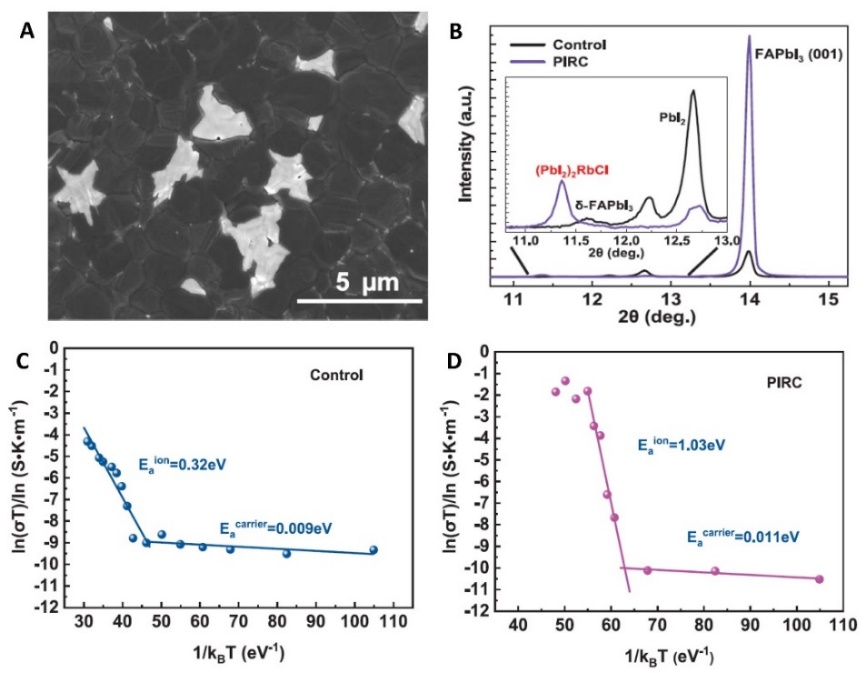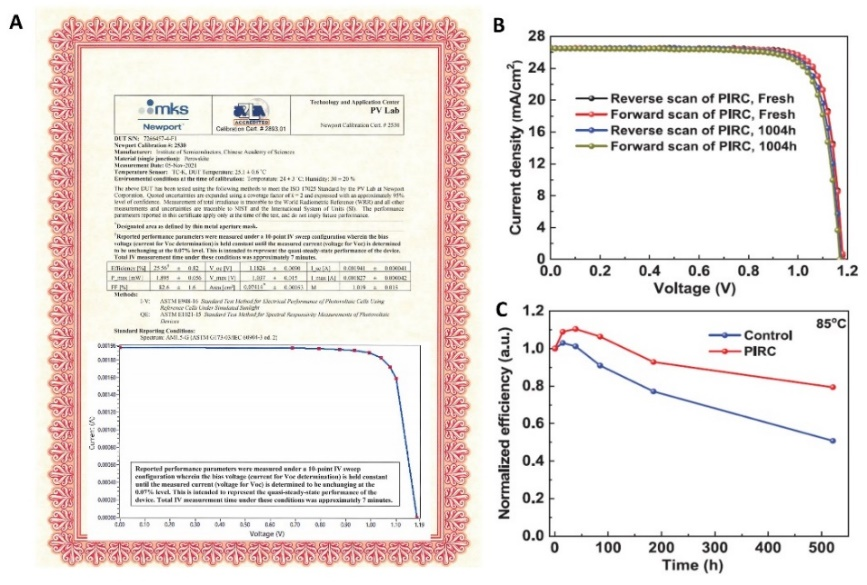Perovskite solar cells (PSCs) gained great attentions recently due to the advantages of low lost and high efficiency. After explosive development within decade, the efficiency of single-junction PSCs and multi-junction perovskite-based solar cells are already beyond 25% and 30%, respectively. The PSCs is regarded as one of the most potential photovoltaic technologies.
In halide PSCs, the formation of secondary-phase excess lead iodide (PbI2) has some positive effects on power conversion efficiency (PCE) but can be detrimental to device stability and lead to large hysteresis effects in voltage sweeps.
In a study published in Science, the group led by Prof. YOU Jingbi from the Institute of Semiconductors of the Chinese Academy of Sciences achieved 25.6% certificated efficiency of PSCs with good stability by using (PbI2)2RbCl to stabilize the perovskite layer.
The researchers developed a small amount of rubidium chloride (RbCl) doping into perovskite materials. The unstable and commonly used secondary phase PbI2 can be converted into a new thermal and chemical stable (PbI2)2RbCl(Figure 1A, 1B). The thermal stability of perovskite material was greatly improved under 85°C conditions, and the ion-migration activation energy of perovskite material was increased by three times, thus the ion migration was effectively suppressed(Figure 1C, 1D).
In addition, they found that by suppressing the PbI2, the bandgap enlargement was eliminated by the strong quantum confinement in perovskite/PbI2 interface, which reduces the bandgap of the perovskite materials, and expands the absorption range of sunlight.
Based on the obtained perovskite material with high stability and optical absorption expansion, the researchers developed PSCs with a certification efficiency of 25.6%(Figure 2A), which is the highest efficiency of single junction of PSCs among the published results. The devices retained 96% of their original PCE values after 1000 hours of shelf storage and 80% after 500 hours of thermal stability testing at 85°C(Figure 2B, 2C).
The findings of this study pave the way for the further development and industrialization of PSCs.
The results were published in the journal of Science (Inactive (PbI2)2RbCl stabilizes perovskite films for efficient solar cells, Science, 2022, 377, 531-534. doi/10.1126/science.abp8873), Dr. ZHAO yang is the leading author of the paper, Ph.D. student MA fei and QU zihan are the second and third authors of the paper respectively, and Prof. YOU jingbi is the corresponding author. This work was carefully guided and strongly supported by Prof. ZHANG xingwang from Institute of Semiconductors, and also supported by Prof. DENG hui-xiong from the Institute of Semiconductors (theoretical simulation of crystal structure) and Prof. YUAN yongbo (ion migration characterization) from Central South University. Prof. YANG yingguo from Shanghai Synchrotron Radiation Facility (SSRF) and Prof. KE weijun from Wuhan University also give their kind help and valuable suggestions.
This work was supported by the National Key Research and Development Program of China, the National Science Foundation for Distinguished Young Scholars, CAS Interdisciplinary Innovation Team, the National Science Foundation for Excellent Young Scholars, and the Innovation-Driven Project of Central South University. The preliminary work of this project was supported by the Beijing Municipal Science & Technology Commission.

Figure 1. (A) SEM image of perovskite contained (PbI2)2RbCl (PIRC). (B)XRD of perovskite without and with PIRC. (C and D) Temperature-dependent conductivity measurements of control and PIRC perovskite films, respectively.

Figure 2. (A) Certificated results from an accredited photovoltaic certification laboratory (Newport, USA). The certificated efficiency is 25.6%. (Inset: Certification J-V curve of device). (B) J-V curves of the PIRC-based device before and after aging in a nitrogen environment for 1004 hours. (C) Thermal stability (85°C) of the control and PIRC-based devices.
